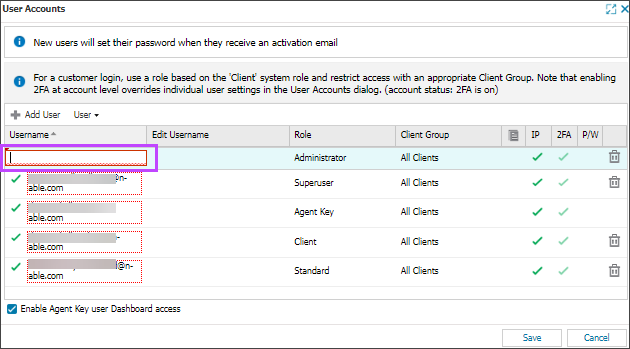Add staff users and assign roles and client groups

Add an N-sight RMM user account for each staff member. Assign a role and a client group to define what the user can do and view in N-sight RMM.
For more information, see:
- Client groups: Determine which client information is available to a user can access in N-sight RMM.
- Roles and permissions: Define what users can do in N-sight RMM.
Prerequisites
- To add a user, you must be signed into N-sight RMM using an Agent Key, a Superuser role , or a user account with the Roles & Permissions permission enabled.
Add an N-sight RMM staff user
- In the All Devices view, go to Settings > Users > User Accounts.
- Select Add User.
- In the Username column, enter an active and valid email address for the user.
Ensure all usernames in the system are active, valid email addresses.
- In the Role column, use the dropdown menu to select a role. To add a new role, select Manage Roles to open the Roles and permissions dialog.
- In the Client Groups column, use the dropdown menu to select a client group. To add a new client group, select Manage Groups to open the Client groups dialog.
Asset Tracking and most N-sight RMM reports, except the User Audit report and the Added and Removed Devices report, are client group aware. This means users only see assets and reports specific to their assigned Clients. For example, when a user selects All Clients from a report drop-down, only reports for their client group are returned.
Since the Client Group drop-down is accessible to Superuser level logins, Agent Key (if Dashboard access is enabled), or a roles with the required Users permissions configured, those users can change the Client Group associated with their own account. -
(Optional) Disable or enable Agent Key user access.
- Select Save, review the changes, then select OK to confirm.
The new user is sent a verification email with a link to set their password and the user password status is displayed in the P/W (Password) column. A green tick indicates a Password is set and an empty tick indicates the Password is not set.
Each user generates their own Two-Factor Authentication (2FA) access code. All actions in the All Devices view are recorded in the User Audit Report.


